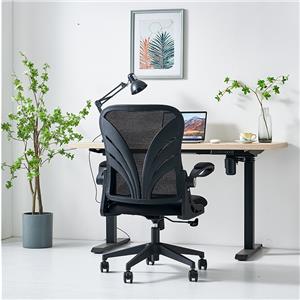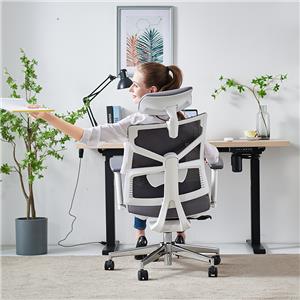Office chair "sitting" improves the comfort of life
The information age is developing rapidly, and more and more people are sitting in front of computers for long periods of time. According to statistics, modern migrant workers spend one-third of their lives in bed, one-third of their lives on the road, and one-third of their lives in a chair. Sitting in an office chair for a long time, discomfort symptoms such as backache and buttocks fever have gradually become the "standard equipment" for workers. So what kind of chair can we choose to improve the comfort of workers sitting for long periods of time?
The first is to look at the shape design of the chair. Office chairs designed to fit the curvature of the human spine not only support body weight, but also provide comfort, effectively relieving the pressure and discomfort caused by long-term sitting.
There are four physiological curvatures in the human spine. From top to bottom, they are neck curvature, chest curvature, waist curvature and sacral curvature. Among them, the curvature of the neck and waist are bulging forward, and the curvature of the chest and sacral flexion are bulging backward. Office chairs with lumbar support and back support not only support the waist and help users maintain a correct sitting posture, they can also disperse the pressure on the back muscles, prevent scoliosis, and reduce the risk of spinal diseases.
The second is to look at the material selection of the chair. When you buy an ergonomic chair and sit on it excitedly, how many embarrassing moments are there when you "can't hold it", "can't press it down", "can't get up", or "your butt is stuffy and wet"? Don't doubt the design of this chair, it's more that the material of the chair is not strong. For an ergonomic chair, the chassis design and seat cushion mesh jointly determine the upper limit of seat comfort.
For example, the heart of an ergonomic chair - the choice of chassis. The choice of chassis is closely related to comfort. Tracing back to the evolution of the chassis in the ergonomic chair industry, compared with previous chassis designs, the space chassis uses aviation fiberglass shrapnel and meets the application requirements of the same level of materials as spacecraft and helicopter rotors. It has a larger elastic stroke and better elastic distribution. Balanced, longer service life. By improving the degree of adjustment and support of the ergonomic chair, we can find a balance between "too heavy to lie down" and "too heavy to get up".
In terms of seat cushion comfort, a seat cushion with a spring device can fully absorb the gravitational potential energy of the user when sitting down, allowing the user to sit down smoothly and naturally, and get up lightly. At the same time, the mesh material is selected with strong support and good breathability, which can effectively solve the stuffy problem caused by sitting for a long time.
The third is to look at the adjustment design of the chair. A practical chair should have adjustable seat cushion height, chair back height, lumbar angle and headrest angle. The correct sitting posture for people at work is to have your feet naturally relaxed on the ground and your knees bent at about 90°. Office chairs with lifting functions allow users to adjust the height of the seat cushion according to their personal height, thereby ensuring that their calves can relax comfortably and naturally and avoid hanging or curling up.
The lumbar and backrests are key components of a seat’s supportive capabilities and are essential for mitigating lower back aches and pains caused by prolonged sitting. The lumbar support equipped with an adjustable angle allows the user to adjust according to changes in individual posture to better fit the waist, thereby providing effective lumbar support; in the back support area, position deviation is inevitable due to height differences between different people. The independently adjustable back support design can solve the problem of "supporting the waist but not the back, supporting the back but not the waist" in traditional chair backs, and meet the individual needs of different people for back support.
The headrest of an office chair is mainly designed to provide support for the neck. Sitting for long periods of time may cause neck fatigue and discomfort, and the presence of a headrest can effectively reduce the burden on the neck muscles. Through up, down, and pitch adjustments, the headrest can better fit the user's neck, helping to maintain the natural curve of the cervical spine and reduce neck fatigue.
In addition to "sitting upright" at work, in daily life, we also sit on a chair and check our mobile phones and close our eyes to relax to relieve the high nervous tension during work. Choosing an ergonomic chair with a large recline angle, stable base, and adjustable waist and back will make entertainment and rest easier, helping us to better restore energy and relieve stress.
Hard-working workers, don’t “make do” with a chair with a single function and no multi-function adjustment. Choose an ergonomic chair that is comfortable to sit on and easy to lie down on, so that it can become a solid “backing” for you in the workplace!




